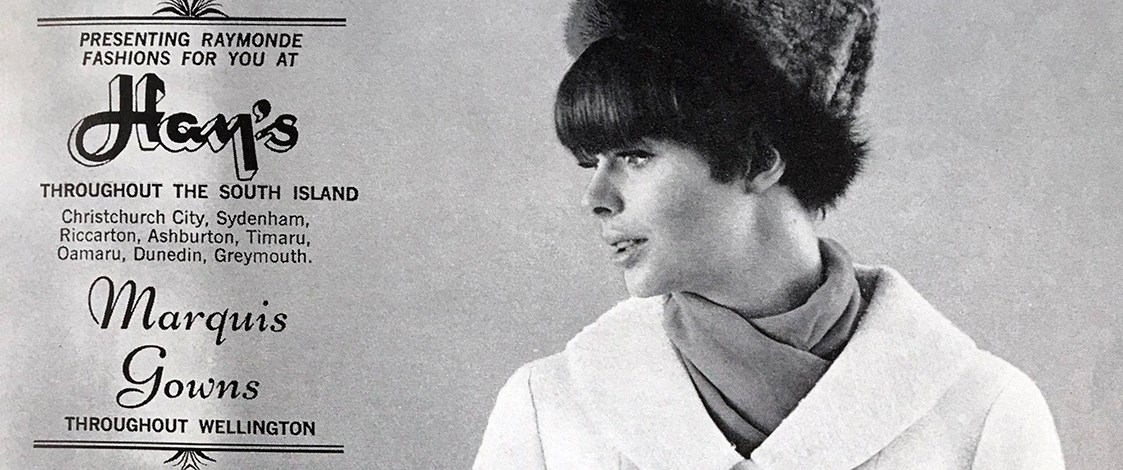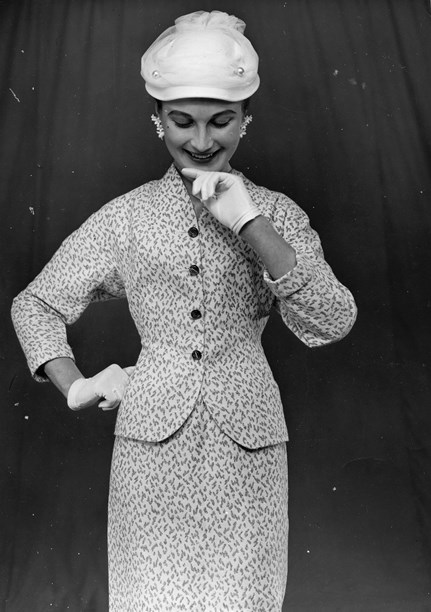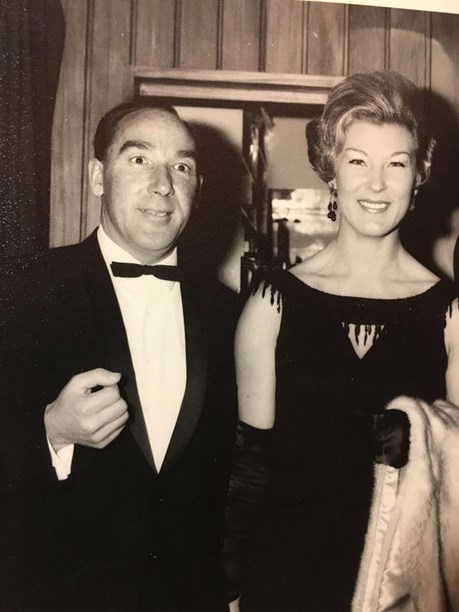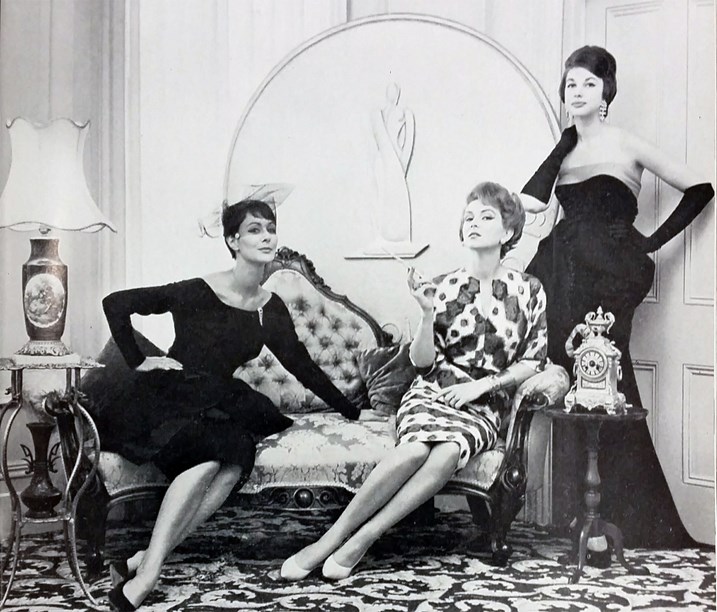Stories
The House of Raymonde
1935-1990

Widely recognised for having their finger on the fashion pulse and for the quality of their make and materials, The House of Raymonde was a successful family business that grew from humble beginnings. Their award-winning designs were sold in stores throughout New Zealand and in their own salons, Marquis and La Ronde.
The House of Raymonde had its beginnings in 1935 when a Wellington mother, Rachel Cohen, started making blouses for the retailer Bing, Harris & Co from her family home. Rachel earnt 15 shillings for a dozen blouses so she bought another sewing machine and hired other machinists to work from her living room. Building a reputation for the quality of her sewing, Rachel expanded into a CMT (cut, make and trim) service and, when the Labour Department deemed her business a factory, she rented space in the Wakefield Chambers building, on the corner of Wakefield and Taranaki Streets. In 1937 she registered her business as Raymond Manufacturing.

Rachel and Jacob Cohen arriving in New Zealand with their son Sidney, April 1925. Image © Cohen Family Archives.
Also known as Raymode or Ray Manufacturing, situations vacant advertisements from the time show she employed machinists, frock pressers, dress improvers and apprentices. Her husband Jacob also joined her in the business.
Sidney had started his career working for the large garment manufacturer Fashions Ltd before leaving to serve overseas in WWII. After the war Sidney remained in London where he studied design and pattern-making. On his return, he drew on his experience at Fashions and came to the conclusion that growth was essential. Sidney put together a sample range of dresses and went out on the road to sell them to retail stores. Sidney’s younger brothers Marcus and Gerald joined the business, now known as the more glamorous, House of Raymonde.

Tina Grenville models a Raymonde fitted jacket and skirt, 1950s.
The Cohens had initially sold their garments wholesale to department stores and retailers across New Zealand but they eventually opened their own salons, called Marquis and later La Ronde, in Wellington and Christchurch.
The Marquis Gowns retail store with model Robin Gaustad, 111 Cuba Street, Wellington, 1961. Photos by K E Niven and Co, courtesy of Alexander Turnbull Library, 1/2-213138-F, 1/2-213139-F and 1/2-213140-F.
Gerald focused on the retail part of the business while Marcus managed production. About this time they started to make overseas labels, such as Sidney Sernack and Sharene, under licence. In 1957, Marcus took over as designer and Sidney moved into management, while Rachel remained active on the board until the 1970s.

Sidney and Krysie Cohen at a Wool Board event, 1960s. Image © Cohen Family Archives.
In New Zealand, the 1950s and 1960s were a time when the latest fashion trends and products were shared by way of fashion parades and competitions. To help build its fashion profile, The House of Raymonde was a frequent participant in these events. Marcus Cohen told The Dress Circle authors (Hammonds, Lloyd Jenkins and Regnault, 2010) that a gold medal at the Wool Awards was considered so significant that the company would dedicate a whole division to perfecting their entries. In 1960, the house won a gold medal for a full-length black wool evening gown with a "trim of mustard and gold beads", a win that allowed them to add a gold medal swing tag to their garments.

The House of Raymonde won a gold medal for a strapless evening gown (right) in the 1960 Wool Awards.
In 1963 the company built a 20,000 sq ft (1,858 sq metre) plant at Rongotai to house their offices, warehouse and manufacturing unit to cater to their growing market. They also established a manufacturing presence in Auckland and Christchurch.
As the fashion landscape changed in the 1960s they understood the need to diversify and to also cater for a new younger customer. Acting boldly on this understanding meant that they were one of the few labels to be included in the 'Young Ideas' pages of Vogue New Zealand alongside labels like Sonny Elegant Knitwear, Miss Deb and Society. Garments from the House of Raymonde frequently appeared in fashion magazines, including the spring 1966 issue of Vogue New Zealand.
The garments they offered were attune to the fashion sensibilities of the youthful women shoppers of this era without losing sight of the needs of their existing customers and the House’s well established reputation for quality.

Artist Dick Frizzell and a model wearing a Raymonde grey flannel suit appeared in a NZ Vogue editorial shoot in 1966.
Aware of the growing population of Auckland, in 1973 the Cohens moved their offices from Wellington to Birkenhead on the North Shore. Many of the staff stayed with the company for decades and the Cohens assisted a dozen families to move to Auckland with the business.
Raymonde designs from the 1970s.
By this time, however, House of Raymonde wasn’t as attune to what was fashionable among young women. When Sidney’s 20-year-old daughter Linda Holloway told him that House of Raymonde clothes weren’t what she would choose to wear, he asked her to do half a dozen designs that would appeal to her age group. "Those took off," Linda explains, "as the stores were hungry for a younger look. This led me to designing four ranges a year for 22 stores under the label Private Collection. Fortunately we had very talented pattern makers and trained tailors."
Linda says that one of Sidney’s strengths was his faith in his staff and his willingness to delegate. "In my early 20s I was travelling around the world buying fabric in Japan, Hong Kong, the United States and Europe. There was a large staff and we had to make sure there was sufficient fabric and designs to ensure the stores were stocked." As well as buying fabric from overseas, they worked with Levana Mills to produce wool fabrics and with independent printers to create printed cottons. "There were hundreds of people in the Birkenhead factory - pattern making, sampling, cutting, production, pressing and dispatch - as well as the accounts and administrative people - all working to stock what would grow to 31 stores." The stores were rebranded as Georgy Girl and La Ronde to appeal to different age groups.
Another new label, Sophisticatz, was introduced in 1983. Sophisticatz designer Jennie Dihm and another House of Raymonde designer Jane Bezar were graduates of the former Wellington Polytechnic School of Fashion (now Massey University's School of Fashion and Textiles) which Marcus Cohen helped to establish.
When Sidney and Gerald retired in the early 1980s, two new directors joined the company. Not long after, in May 1984, they sold the business to Nancy and Arthur Delaney, who owned the Puritan label. After a short time in Birkenhead, Nancy and Arthur moved their businesses back to the Auckland CBD. They continued there until the end of 1985 when they in turn retired, selling their fashion businesses to Thornton Hall.
During its 50-year existence, The House of Raymonde made a significant impact on the New Zealand fashion scene. Their willingness to move with the times and the introduction of new, younger designs enabled them to remain in business longer than many of their rag-trade associates.
Text by Kelly Dix.
First published February 2020, updated June 2020.